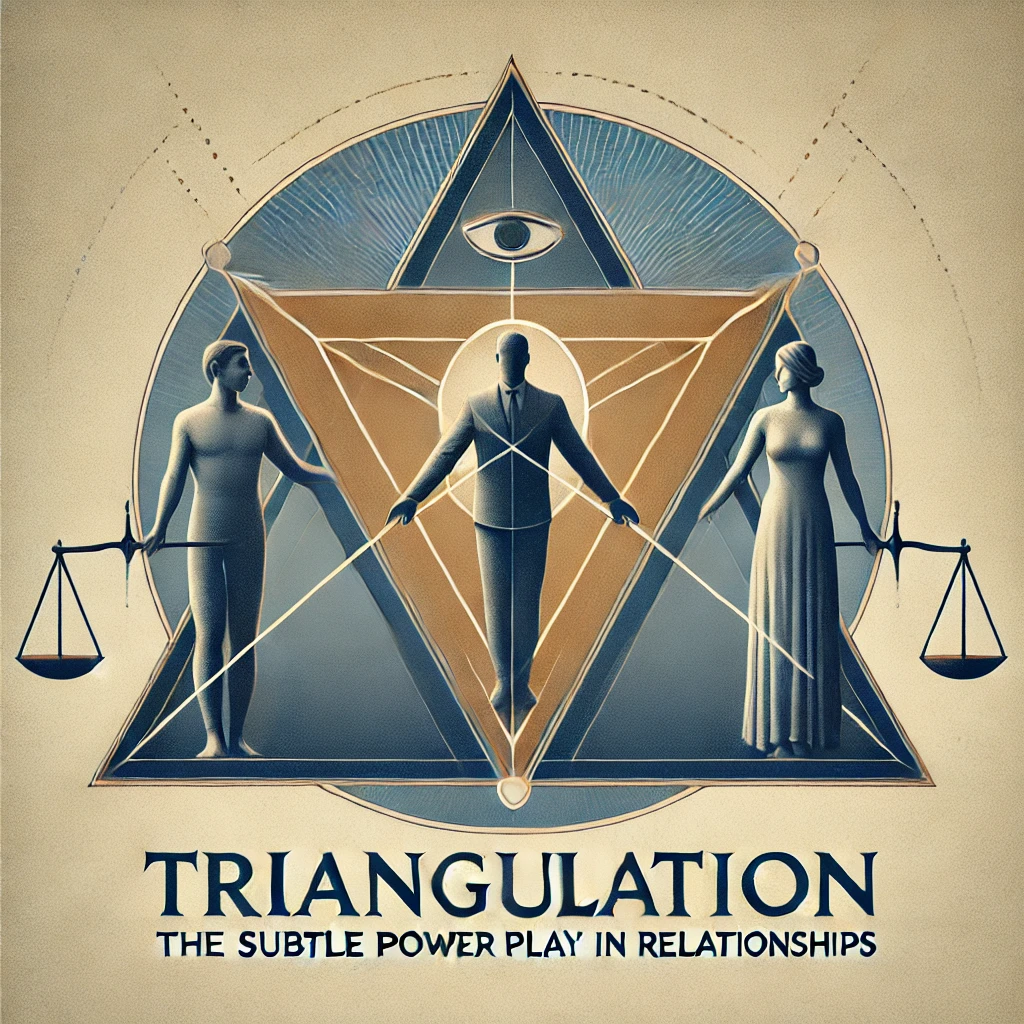In any relationship, communication is key, but what happens when a third party is introduced into the conversation—either directly or indirectly? This is where triangulation comes into play. Triangulation is a subtle, yet powerful, manipulation tactic that occurs when one person brings a third party into a relationship dynamic, whether to shift power, gain support, or create division. It’s a psychological play that can be both toxic and divisive, but also incredibly effective when used deliberately to influence outcomes.
In “Mastering Him: The Secret Art of Gentle Control in Relationships”, Chapter 8 uncovers the hidden power of triangulation, explaining how this controversial tactic works and how it’s used in relationships to subtly manipulate dynamics, shift power, and control outcomes. It’s not always as obvious as it sounds, and often, the person on the receiving end may not even realize they’re being influenced by this tactic.
Triangulation can appear in many forms—from invoking the opinion of a third party to making comparisons with an ex-partner. Whether it’s bringing in a friend, family member, or someone from your past, the purpose is to manipulate the situation by using someone else’s influence. Let’s break down how triangulation works, why it’s effective, and how to recognize it in your own relationship.
By the end of this blog, you’ll understand how triangulation operates, why people use it, and how you can identify and respond to it in your relationship dynamics.
What Is Triangulation?
Triangulation occurs when one person involves a third party in their relationship, either to create division, gain leverage, or control the dynamic. The key to triangulation is that the third party is often used as a tool to indirectly influence the behavior of the second person. This can happen in romantic relationships, friendships, family dynamics, or even at work.
Triangulation can take many forms:
- Bringing up an ex-partner to make the current partner feel insecure or pressured.
- Invoking a family member’s opinion to justify a position in an argument.
- Using a mutual friend’s support to validate one’s feelings or actions.
The goal of triangulation is often to manipulate the relationship’s emotional balance by shifting focus away from the real issue and introducing a third element that serves to distract, control, or destabilize the other person.
Why Does Triangulation Work in Relationships?
Triangulation works because it destabilizes the relationship’s direct communication. When a third party is introduced, the focus shifts from being a two-person dynamic to a triangle of emotions, opinions, or comparisons. This often creates an imbalance where one partner feels insecure, uncertain, or more vulnerable.
By invoking someone else’s opinion, approval, or status, the triangulator can exert pressure on their partner, subtly controlling the narrative and influencing the partner’s decisions, emotions, or behaviors. The person being triangulated against often feels less secure or less certain of their own stance, making them more likely to comply with the triangulator’s wishes.
This tactic can be emotionally damaging over time, as it fosters division, insecurity, and resentment. But for those using it as a tool, triangulation can offer short-term leverage by manipulating emotional vulnerabilities.
Real-Life Examples of Triangulation in Relationships
Let’s explore some real-life examples of how triangulation might show up in everyday interactions. These examples will give you a clearer understanding of how this tactic can be used to subtly manipulate relationship dynamics.
Example 1: The Ex-Partner Comparison
One of the most common forms of triangulation occurs when a partner brings up an ex in conversation—whether subtly or overtly. This can be used to create insecurity or to steer behavior in a certain direction.
Triangulation in Action:
Imagine your partner says, “You know, my ex used to always plan fun surprises for me. I really appreciated that.” On the surface, it might sound like a simple statement, but the underlying message is clear: they’re comparing you to their ex, and you’re falling short. This creates insecurity, making you feel like you need to step up your game or risk being seen as less-than.
Why It Works:
By invoking the ex, your partner has introduced a third party into the relationship, creating a comparison that shifts the power dynamic. You feel pressured to prove yourself or change your behavior to meet this unspoken expectation, even if it wasn’t directly asked.
Example 2: The Family Approval Manipulation
Another classic example of triangulation is when a partner brings up family members—often parents—to influence decisions or validate their stance in an argument.
Triangulation in Action:
During a disagreement about finances, your partner says, “My mom always said it’s important to save aggressively. She’s been right about everything so far, so we should listen to her.” Here, your partner is invoking their parent’s authority to justify their position, shifting the conversation away from a two-person discussion to a dynamic where the parent’s approval or opinion carries significant weight.
Why It Works:
This tactic uses the third party’s authority to undermine your stance, making you feel like you’re going against not just your partner, but a respected figure as well. It adds emotional pressure and makes it harder for you to stand your ground, as you’re now arguing against both your partner and their parent’s opinion.
Example 3: The Friend Validation
Sometimes, triangulation involves bringing a friend into the conversation to back up one’s point of view or actions, creating a scenario where it feels like “everyone” agrees with the triangulator.
Triangulation in Action:
You express frustration about your partner’s lack of effort in planning dates, and they respond by saying, “Well, I was just talking to Sarah, and she thinks I’m a great partner. She said she’d love to be with someone like me who’s so laid-back. Maybe you’re being too demanding.” By invoking the friend’s opinion, your partner is not only deflecting your concerns but also making you feel like your expectations are out of line with what others consider normal.
Why It Works:
This creates a feeling of isolation—like you’re the odd one out for wanting more effort in the relationship. The friend’s opinion becomes a tool for dismissing your concerns, making you question whether you’re being unreasonable or difficult.
Example 4: The Co-Worker Comparison
Triangulation can also occur in professional settings when a partner brings up a co-worker’s habits, success, or performance to influence behavior in the relationship.
Triangulation in Action:
Your partner might say, “Jessica from work always talks about how her husband helps out so much at home. She’s so lucky—her life seems so balanced. It would be nice if we could have that balance too.” This creates a subtle comparison, suggesting that you’re not doing enough at home, without directly criticizing you. The reference to Jessica’s life puts pressure on you to improve, based on this outside example.
Why It Works:
By introducing a third party’s relationship into the conversation, your partner creates an external benchmark for comparison, which can make you feel like you need to step up in order to match these idealized standards. This can foster insecurity and create pressure to change.
Why People Use Triangulation
People use triangulation for various reasons, but at the core, it’s about control. By introducing a third party into the relationship dynamic, the triangulator shifts the emotional balance in their favor. Whether they’re seeking validation, trying to win an argument, or creating division to maintain power, triangulation allows them to manipulate the emotional landscape without directly confronting the issue.
Often, triangulation is used because it feels less aggressive than direct confrontation. Instead of saying, “You’re not doing enough,” the triangulator can say, “Look at how someone else is doing it better,” making the message feel less personal but still highly impactful.
However, this tactic can be emotionally damaging, as it erodes trust, creates insecurity, and fosters resentment over time.
How to Recognize and Respond to Triangulation
If you suspect triangulation is happening in your relationship, here are some signs to watch out for:
- Constant comparisons to other people: Whether it’s an ex, a friend, or a family member, if your partner regularly brings up third parties in discussions, this could be a form of triangulation.
- Use of outside opinions to validate their stance: If your partner frequently invokes others’ approval or opinions to back up their own position, they may be triangulating to strengthen their argument.
- Feelings of insecurity or comparison: If you find yourself constantly feeling like you’re not measuring up because of comparisons to others, triangulation may be at play.
To respond to triangulation, it’s important to bring the focus back to the two of you, without allowing the third party to take center stage:
- Acknowledge the tactic: “I hear what you’re saying about your friend, but I think our relationship is unique, and I want to focus on what works for us.”
- Refocus the conversation: “I understand your mom’s advice, but I’d like us to make this decision based on what feels right for us, not outside opinions.”
Q&A:
- What is triangulation in relationships?
- Explanation of the term, how it affects relationships, and common scenarios where it appears.
- How does triangulation work as a manipulation tactic?
- A breakdown of how triangulation subtly shifts dynamics in a relationship and influences behavior.
- What are signs of triangulation in relationships?
- Key indicators to look for when someone might be using triangulation.
- Why do people use triangulation in relationships?
- Insights into the psychological motivations and reasons behind triangulation.
- How to respond to triangulation in a relationship?
- Practical advice on handling triangulation without escalating conflict.
- What are examples of triangulation in relationships?
- Real-life scenarios illustrating how triangulation can play out in romantic and personal dynamics.
- Is triangulation a form of emotional abuse?
- Exploring whether triangulation can cross the line into emotional abuse and the impact on mental health.
- How to stop triangulation from damaging a relationship?
- Steps to counteract triangulation and strengthen direct communication.
- What are the effects of triangulation on trust and intimacy?
- Discussion of how triangulation impacts feelings of trust, security, and closeness in relationships.
- How to recognize if you are triangulating in your relationship?
- Self-reflective tips for recognizing unintentional triangulation and fostering healthier dynamics.
Ready to Master the Art of Influence in Your Relationship?
If you’re ready to dive deeper into the subtle tactics of influence like triangulation, and learn how to navigate these complex dynamics in a way that strengthens your relationship, “Mastering Him: The Secret Art of Gentle Control in Relationships” is your essential guide. In Chapter 8, you’ll discover how to recognize, respond to, and even harness
powerful techniques like triangulation to maintain balance and harmony in your relationship.
This book isn’t just about manipulation—it’s about understanding the deep psychological tactics at play in every relationship and using them responsibly to create lasting connection and influence. Get your copy today and start mastering the art of subtle control in your relationship—because the power to shape your relationship is in your hands.
Read more about the book: https://developmentpill.com/mastering-him-the-secret-art-of-gentle-control-in-relationships-a-guide-to-influence-hell-never-see-coming/
Book Link: https://www.amazon.com/dp/B0DKKGLZQ9
Book Link UK: https://www.amazon.co.uk/dp/B0DKKGLZQ9
You can find book Links for other regions in this post page: https://developmentpill.com/mastering-him-the-secret-art-of-gentle-control-in-relationships-a-guide-to-influence-hell-never-see-coming/



